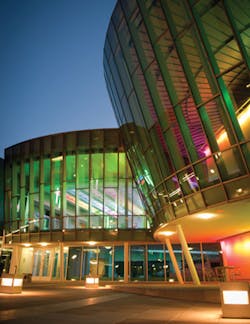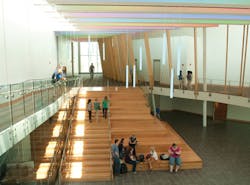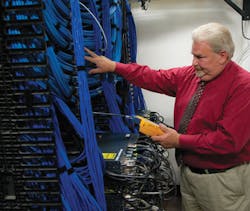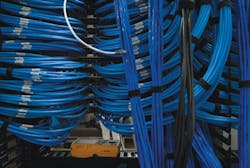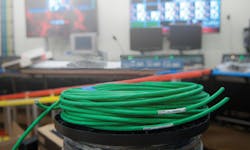Campus brings fiber and Cat 6A to the desk for advanced learning
Northern Kentucky University’s College of Informatics is a physical embodiment of a social network.
By Chris Cole, Northern Kentucky University
Located on 400 acres in the quiet suburb of Highland Heights, KY, just seven miles southeast of Cincinnati, Northern Kentucky University (NKU) is a growing metropolitan university of nearly 16,000 students served by more than 2,500 faculty and staff. NKU provides a private-school-caliber education for a fraction of the cost and is one of the fastest growing universities in Kentucky, made obvious by a unique high-tech building on campus that captures the attention of passersby with its protruding glass Digitorium.
This fall, NKU celebrates the opening of Griffin Hall, the new state-of-the-art $52.8 million home to the College of Informatics. It is 134,000 square feet of high-tech learning space and has been described by one student as the physical embodiment of a social network. The facility is an appropriate host to one of only a handful of colleges in the country devoted entirely to informatics—the study, development and application of digital technology, information and communication in all aspects of society, from business and law to arts and science. The only building of its kind in the region, Griffin Hall was based upon the realization that traditional academic structures don’t provide the optimal environment to the digital and information revolutions impacting every aspect of human activity. Accordingly, the new technology hub of the region offers a different kind of physical environment optimized by advanced digital technology—all of which is supported by an advanced network cabling and connectivity infrastructure.
“In actuality, the field of informatics is all about connectivity and bringing together areas of study that digitally connect to the world and each other,” says Dr. Kevin Kirby, interim dean for the College of Informatics. “The digital age is all about data, and while it can flow through the air, big data still needs the cabling infrastructure. The new facility is very different from anything that was built just 10 years ago, and its massive connectivity is very important to informatics.”
Targeted to achieve silver certification under the U.S. Green Building Council’s LEED (Leadership in Energy and Environmental Design) program, Griffin Hall is a true intelligent building. It includes an electronic media lab, a health informatics lab, a media informatics digital lab and a large performance studio. At the heart of the new building is the two-story Digitorium, a 120-seat digital auditorium that includes a wall of contiguous digital displays, a 2-D digital cinema projection system, a professional control room and eight “opera boxes” that also serve as break-out rooms with computational equipment where participants can actively engage with an event. Highly configurable, the Digitorium will host a wide range of high-tech events, from virtualized performances to collaborative gaming and digital film festivals.
“If one just considers the screens in this facility—from the giant wall of display tiles in the Digitorium, to the tinyThe new facility also has space allocated for a future computer-assisted virtual environment, known as the CAVE, which will be an immersive environment that allows people to literally enter a virtual world.
“The CAVE will be used for research and courses that involve visualization of complex data,” explains Kirby. “When 2-D plots are not enough for exploring complex data, 3-D scientific visualization is required. The technology in this space will be rolled out over the next couple of years and will require extremely high bandwidth.”
Even the main lobby of Griffin Hall is unlike any other. Using digital technology, the lobby conveys that the building is alive with digital projectors that display on the outside walls of the Digitorium. It also includes an IP-addressable LED ceiling lighting system and a digital gallery that can dynamically present the current work of students and faculty.
Choosing state-of-the art technology
With the sheer amount of advanced digital technology and applications, it’s no wonder that NKU needed to implement an advanced network cabling infrastructure in Griffin Hall. The university decided to install an infrastructure capable of supporting 10 Gigabits per second (Gbits/sec) today and 40 or 100 Gbits/sec in the future, including a combination of augmented Category 6 unshielded-twisted pair copper and singlemode optical fiber to the desktop.
“As everyone knows, it’s very difficult to plan for the future with the rapid and unpredictable changes in technology,” says Rob Knarr, associate director and senior project manager for NKU. “As part of such a transcending project, we definitely did not want to install our current campus cabling standard and only prepare for today’s technology. We decided that a Category 6A solution and singlemode fiber best prepared the building’s infrastructure for future bandwidth capacity.”
With the initial infrastructure design completed and cabling technology determined, NKU released a request for proposal (RFP) and established a review and evaluation committee to score all proposals based on a specific set of criteria including expertise, service and price. In the competitive bidding process, CTS Telecommunications (www.ctstelecomm.com) of Cincinnati responded to the RFP with a PanGen structured cabling solution, featuring advanced network cable from General Cable (www.generalcable.com) and connectivity from Panduit (www.panduit.com). According to NKU, CTS was the highest scoring contractor with an overall proposal that provided the most value. General Cable’s headquarters happens to be located in Highland Heights, KY, adjacent to the NKU campus.
“Between the two specified solutions in the RFP, we knew that General Cable was NKU’s preferred cable for Category 6A,” says Rick Setzer, president of CTS. “We’ve completed several projects on the NKU campus over the past eight years, but this was the first time our technicians would be installing a Category 6A cabling solution and singlemode fiber-to-the-desk for the horizontal cabling.”
The copper PanGen solution selected for Griffin Hall provides certified 10-Gbit/sec channel performance up to 100 meters and includes the GenSPEED 10 MTP (Mosaic Twisted Pair) that exceeds the TIA-568-C.2 component standards. GenSPEED 10 MTP uses a patented Mosaic Crossblock technology that encompasses individual overlapping metallic blocks separated by an insulating layer of polymer film to shield the cable from noise coming from external cable sources, which can adversely impact data transmission performance. The cable also incorporates a separator to stabilize and separate each pair for optimized internal pair geometry and crosstalk performance, while providing an overall smaller, easy-to-install round cable profile.
“Because it was our first time terminating the GenSPEED 10 MTP cable with Panduit connectors, our technicians received hands-on training and were shown how to use a tool that makes terminating the jacks very simple,” says Eric Shifferd, project manager with CTS. “It maybe took us about 5 percent more time to terminate than previous categories of cable, but it was nothing out of the ordinary—especially for a facility like Griffin Hall.”
For the optical fiber solution in the backbone cabling infrastructure and fiber-to-the-desk applications, NKU selected NextGen Brand singlemode optical fiber cabling from General Cable and a combination of SC and LC field-installable connectors from Panduit.
“We talked about deploying multimode optical fiber, but we believe that we will eventually be at 40- or 100-Gigabit speeds, and we just couldn’t guarantee that those speeds would work over multimode fiber and the distances we needed to cover,” explains Bob Weber, senior manager of infrastructure services for NKU.
An infrastructure like no other
In an infrastructure deployment that began in late August 2010, CTS installed a redundant singlemode optical fiber backbone to connect Griffin Hall to the two main campus core switches located in the NKU Student Union and Applied Science & Technology (AS&T) buildings, as well as 300-pair copper cabling for backup telephone applications. From the main distribution facility (MDF) on the first floor of Griffin Hall, CTS installed 12 strands of General Cable singlemode optical fiber through 4-inch conduit to a stacked, centrally located telecommunications room on each of the five floors. Another 12 strands of singlemode optical fiber connected separate academic-specific server rooms and audio-visual control rooms to the MDF—one of which supports technology in the Digitorium.
From each of the telecommunications rooms, CTS deployed the GenSPEED 10 MTP cable to every space, for a total of approximately 3,000 work area outlets, including 233 Power over Ethernet (PoE) wireless access points throughout the facility. In high-tech classrooms, anywhere from 24 to 36 connections were installed in the floor, and another 40 or more connections in the wall. In addition to standard data transmission, the work area outlets throughout the facility connect a variety of equipment to the network for applications such as Voice over IP telephony, digital signage, video, security, life safety, building automation systems and audio-visual control.
For example, NKU decided to implement a Category 6A connection outside of each classroom to display the room’s class schedule using digital signage technology. “We are currently scheduled to have digital schedules outside of the two main building conference rooms, and each of the 33 classrooms currently has a data drop outside the door so that we can eventually have digital signage throughout,” says Weber.
Six strands of NextGen singlemode optical fiber were also run to more than 200 fiber-to-the-desk locations. “We wanted fiber to every classroom, teaching space and conference room to futureproof for 40-Gigabit Ethernet, and to support advanced audio-visual equipment that uses fiber,” says Weber. “We also installed fiber in the dean’s office and other high-tech offices to be used for advanced technology that is set up for transmitting directly over fiber.”
In each telecommunications room, the GenSPEED 10 MTP terminates to Panduit’s PViQ patch panels with intelligent modules that support the use of physical infrastructure management software for tracking IT assets and network configurations.
“We implemented the intelligent infrastructure management capabilities on all copper patch panels, but we will set it up in just one location at first to understand how to use it effectively,” says Weber. “It will ultimately help us monitor port-to-port IP addresses to easily track devices on the network.”
Installation of the network cabling infrastructure was a smooth, well-coordinated process made possible through excellent teamwork. According to John Diss, project manager at CTS, the significant amount of both copper and optical fiber cabling made it a challenge to ensure plenty of space in pathways and telecommunications spaces, especially once it was determined that each telecommunications space required its own computer room air-conditioning (CRAC) unit. At any point during the installation, CTS had as many as 12 technicians on site ensuring that the entire infrastructure was installed properly and on schedule.
“The telecommunications rooms were tight, and we ran into a few pathway challenges due to the LEED certification of the facility and some interesting architecture,” says Shawn Tracy, lead technician for CTS who has 15 years of experience. “In some instances, we had to be creative to get the network cable from point A to B.”
Ultimately, the entire network infrastructure was implemented and tested with no failures, allowing the network to go live in May 2011. Occupants began moving into Griffin Hall in June and classes started in late August. While some audio-visual technology aspects were still ongoing at the time of this writing, Griffin Hall is expected to be fully completed in October.
“NKU has been very progressive from a technology standpoint, and our goal is to support them in their endeavors,” says Setzer of CTS. “The team on this project worked very well together, and product delivery and availability from Graybar of Cincinnati was on target. Part of that comes from a longstanding relationship and good communication between all parties.”
A new-world environment
NKU’s College of Informatics at Griffin Hall will ultimately house the most advanced technology in the Midwest. In addition to attracting new talent to NKU and supplying technically skilled and broadly prepared workforce talent to the region, the College of Informatics at Griffin Hall will be a highly public venue, providing unique and inviting spaces that the public and businesses will want to use for their own events and activities. Much of what will go on inside Griffin Hall—all supported by the PanGen network infrastructure—is more advanced than what most can imagine.
While NKU has always strived for sustainable design decisions on all projects, as the first LEED-certified“We’re going to have a mock network operations center that will be more of a display for teaching and demonstrating key information about the facility,” says Weber. “It will show power levels and other information to teach students about intelligent buildings. It will also show live data transmission and other behind-the-scenes technologies.”
Each classroom in the new facility also includes advanced audio-visual teaching technologies like smart-boards, projector systems and networked controllers that can adjust shades and lighting as necessary. IP-based class-capture cameras can digitally record classes for online and remote distance learning. The Cisco VoIP phones throughout the facility are video phones, and wireless IP phones will be provided to faculty and staff.
While the teaching, learning and day-to-day facility operations at the College of Informatics will be like nothing NKU students and faculty have ever experienced, they can rest assured that the PanGen network cabling infrastructure with GenSPEED 10 MTP and NextGen singlemode fiber will support whatever advanced digital technologies they can study, develop and apply in the field of informatics—from sophisticated data mining software and digital art and film, to cybersecurity development and 3-D visualization.
“With the College of Informatics, we are creating a magnet to attract new students, faculty and researchers. Expectations are very high and increasing year by year,” says Kirby. “A lot of eyes are on the NKU College of Informatics, and it has to be cutting-edge with an infrastructure that maintains high performance and reliability. While academic buildings and needs change over time, at this point, we are quite confident in the technology we’ve implemented.”
Chris Cole is Northern Kentucky University’s (www.nku.edu) director of marketing and communications.
